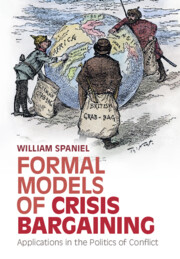Refine search
Actions for selected content:
37615 results in Cambridge Textbooks
Appendix D - Solutions TO END-OF-CHAPTER EXERCISES
-
- Book:
- Statistics Using R
- Published online:
- 07 December 2023
- Print publication:
- 07 December 2023, pp 688-688
-
- Chapter
- Export citation

Integrated Circuit Fabrication
- Science and Technology
-
- Published online:
- 01 December 2023
- Print publication:
- 16 November 2023
-
- Textbook
- Export citation

Formal Models of Crisis Bargaining
- Applications in the Politics of Conflict
-
- Published online:
- 30 November 2023
- Print publication:
- 09 November 2023
-
- Textbook
- Export citation

Integrated Digital Marketing in Practice
-
- Published online:
- 30 November 2023
- Print publication:
- 13 April 2023
-
- Textbook
- Export citation
Chapter Six - Simple Linear Regression
-
- Book:
- Statistics Using Stata
- Published online:
- 26 January 2024
- Print publication:
- 30 November 2023, pp 204-230
-
- Chapter
- Export citation
Dedication
-
- Book:
- Statistics Using Stata
- Published online:
- 26 January 2024
- Print publication:
- 30 November 2023, pp v-vi
-
- Chapter
- Export citation
Chapter Three - Measures of Location, Spread, and Skewness
-
- Book:
- Statistics Using Stata
- Published online:
- 26 January 2024
- Print publication:
- 30 November 2023, pp 75-118
-
- Chapter
- Export citation
Appendix D - Nonlinear Optics and Spontaneous Parametric Down-Conversion
-
- Book:
- Introductory Quantum Optics
- Published online:
- 14 December 2023
- Print publication:
- 30 November 2023, pp 406-407
-
- Chapter
- Export citation
Appendix D - Solutions
-
- Book:
- Statistics Using Stata
- Published online:
- 26 January 2024
- Print publication:
- 30 November 2023, pp 745-745
-
- Chapter
- Export citation
Appendix A - Data Set Descriptions
-
- Book:
- Statistics Using Stata
- Published online:
- 26 January 2024
- Print publication:
- 30 November 2023, pp 707-719
-
- Chapter
- Export citation
2 - Field Quantization
-
- Book:
- Introductory Quantum Optics
- Published online:
- 14 December 2023
- Print publication:
- 30 November 2023, pp 11-49
-
- Chapter
- Export citation
4 - Emission and Absorption of Radiation by Atoms
-
- Book:
- Introductory Quantum Optics
- Published online:
- 14 December 2023
- Print publication:
- 30 November 2023, pp 89-133
-
- Chapter
- Export citation
Chapter Eighteen - Non-parametric Methods
-
- Book:
- Statistics Using Stata
- Published online:
- 26 January 2024
- Print publication:
- 30 November 2023, pp 626-659
-
- Chapter
- Export citation
5 - Quantum Coherence Functions
-
- Book:
- Introductory Quantum Optics
- Published online:
- 14 December 2023
- Print publication:
- 30 November 2023, pp 134-154
-
- Chapter
- Export citation
Appendices
-
- Book:
- Statistics Using Stata
- Published online:
- 26 January 2024
- Print publication:
- 30 November 2023, pp 707-745
-
- Chapter
- Export citation
7 - Nonclassical Light
-
- Book:
- Introductory Quantum Optics
- Published online:
- 14 December 2023
- Print publication:
- 30 November 2023, pp 191-256
-
- Chapter
- Export citation
Preface
-
- Book:
- Statistics Using Stata
- Published online:
- 26 January 2024
- Print publication:
- 30 November 2023, pp xv-xviii
-
- Chapter
- Export citation
9 - Optical Test of Quantum Mechanics
-
- Book:
- Introductory Quantum Optics
- Published online:
- 14 December 2023
- Print publication:
- 30 November 2023, pp 280-307
-
- Chapter
- Export citation
Acknowledgments
-
- Book:
- Statistics Using Stata
- Published online:
- 26 January 2024
- Print publication:
- 30 November 2023, pp xix-xx
-
- Chapter
- Export citation
Index
-
- Book:
- Introductory Quantum Optics
- Published online:
- 14 December 2023
- Print publication:
- 30 November 2023, pp 408-414
-
- Chapter
- Export citation
